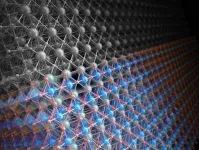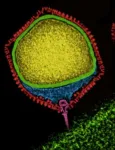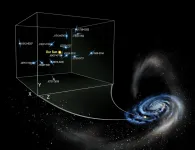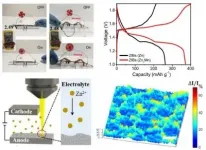INFORMATION:
This work was funded in part by NIH grants R37 AI058072, R56 AI103325, F30 CA236182, and F30 CA196040. Additional authors on the paper are Robert Tyler, PhD, former MCW post doc and current scientist at ThermoFisher; Jamie Fox, PhD, MCW alumna and current scientist at Marshfield Clinic; Andrew Kleist, MD-PhD student at MCW; M. Madan Babu, PhD, Faculty and Center Director in the Departments of Structural Biology and Center for Data Driven Discovery at St. Jude Children's Research Hospital; Kenneth Prehoda, PhD, professor at the Institute of Molecular Biology and Department of Chemistry and Biochemistry at the University of Oregon; and Francis Peterson, PhD, professor of biochemistry at MCW.
Cracking the code of a shapeshifting protein
2021-01-11
(Press-News.org) A shapeshifting immune system protein called XCL1 evolved from a single-shape ancestor hundreds of millions of years ago. Now, researchers at the Medical College of Wisconsin (MCW) discovered the molecular basis for how this happened. In the process they uncovered principles that scientists can use to design purpose-built nanoscale transformers for use as biosensors, components of molecular machines, and even therapeutics. The findings were published today in Science. The primary and senior authors of the manuscript, respectively, are MCW researchers Acacia Dishman, MD-PhD student, and Brian Volkman, PhD, professor of biochemistry.
Molecular switches can be used to detect cancer, construct nanoscale machines, and even build cellular computers. Many currently available molecular switches, however, rely on transcription and translation to switch "on," and cellular degradation to turn "off," meaning that they work slowly and sometimes irreversibly. Turning them on is like driving to the store, buying a lightbulb, going back home and screwing it in; and turning them off is like waiting for the bulb to burn out. Research efforts in the field have thus been devoted to developing molecular switches that work more like flicking a light switch on, and off, and on again. One way to build such switches would be to use metamorphic proteins: proteins that can adopt more than one distinct 3D shape, even under identical physiological conditions. But until now it has been difficult to define a workflow for intentional design of metamorphic proteins that could serve as nanoscale transformers optimized to perform specific biomedical functions.
Dishman and colleagues sought inspiration from nature to understand the molecular principles needed to create proteins that can assume either of two stable shapes in equilibrium. They studied the evolution of a naturally occurring metamorphic protein called XCL1, which performs two important and distinct functions in the human immune system. One conformation plays a role in directly killing invaders like viruses and bacteria, while a second attracts dendritic cells to recognize foreign antigens and kill the cells, like cancer cells, presenting them. Looking back in evolutionary time, the MCW team found that XCL1 evolved from an ancient, single-structure protein. Then about 200 million years ago XCL1 gained the power to shape-shift. By zeroing in on the precise historical timepoint when the protein started shifting between two shapes, the researchers were able to decipher the molecular code that allowed the molecular ancestors of the human XCL1 protein to become a transformer. In cracking this code, Dishman, et al. have outlined an "instruction manual" for engineering metamorphic proteins. These principles should be useful in a variety of applications, from developing biosensors to building nanoscale machines. It may now be possible, for example, to design a microscopic biobot incorporating a transformer protein acting as a drug delivery vehicle: In one conformation present in the circulation, the payload of cancer-killing drugs would remain isolated in the cargo bed. Upon approaching a tumor, signals from the cancer cells would switch the metamorphic protein into its other conformation, releasing the drug precisely at the tumor site and avoiding the damage to normal tissues that can make cancer patients sick.
"It has been an honor to work on this project," says Dishman, a fourth-year graduate student in MCW's physician scientist training program. "Our discoveries dispel some long-held misconceptions about fold switching proteins and their role in evolutionary biology. These results suggest that there may be far more shapeshifting proteins out there in the world than we ever expected. This project has been in the lab for almost a decade and it's been rewarding to solve some of the difficult questions about the evolution of XCL1. Brian gave me freedom to pursue ideas I thought were interesting and to tell the story in ways that challenge the norms in our field, and for that I am grateful. I'm thrilled to get these findings published to the broader scientific community and hope that we can go on to devise technologies that directly apply these concepts for the benefit of patients."
Adds Volkman, senior author and director of the MCW program in Chemical Biology, "Acacia's Science paper is the culmination of work that spanned many years. It does not diminish her major achievement to point out that other talented people laid the foundation, and I am grateful to all of them, especially Rob Tyler, who launched the study of XCL1 ancestor proteins. I agree with Acacia that her paper is likely to become an important landmark for the study of metamorphic proteins. Her work demonstrates that fold switching is not a biological accident but a feature that can be preserved and optimized over evolutionary time scales. I expect her paper will put to rest an alternative view that metamorphic proteins arise only as temporary, intermediate steps in the emergence of new protein structures."
ELSE PRESS RELEASES FROM THIS DATE:
Study shows tweaking one layer of atoms on a catalyst's surface can make it work better
2021-01-11
Scientists crafting a nickel-based catalyst used in making hydrogen fuel built it one atomic layer at a time to gain full control over its chemical properties. But the finished material didn't behave as they expected: As one version of the catalyst went about its work, the top-most layer of atoms rearranged to form a new pattern, as if the square tiles that cover a floor had suddenly changed to hexagons.
But that's ok, they reported today, because understanding and controlling this surprising transformation gives them a new way to turn catalytic activity on and off and make good catalysts ...
NIH study suggests using cannabis while trying to conceive may reduce pregnancy chances
2021-01-11
Women who use marijuana could have a more difficult time conceiving a child than women who do not use marijuana, suggests a study by researchers at the National Institutes of Health. Marijuana use among the women's partners--which could have influenced conception rates--was not studied. The researchers were led by Sunni L. Mumford, Ph.D., of the Epidemiology Branch in NIH's Eunice Kennedy Shriver National Institute of Child Health and Human Development. The study appears in Human Reproduction.
The women were part of a larger group trying to conceive after one or two prior miscarriages. Women who said they used cannabis products--marijuana or hashish--in the weeks before pregnancy, or who had positive urine tests for cannabis ...
'Galaxy-sized' observatory sees potential hints of gravitational waves
2021-01-11
Scientists have used a "galaxy-sized" space observatory to find possible hints of a unique signal from gravitational waves, or the powerful ripples that course through the universe and warp the fabric of space and time itself.
The new findings, which appeared recently in The Astrophysical Journal Letters, hail from a U.S. and Canadian project called the North American Nanohertz Observatory for Gravitational Waves (NANOGrav).
For over 13 years, NANOGrav researchers have pored over the light streaming from dozens of pulsars spread throughout the Milky ...
How the circadian clock regulates liver genes in time and space
2021-01-11
Nothing in biology is static. Biological processes fluctuate over time, and if we are to put together an accurate picture of cells, tissues, organs etc., we have to take into account their temporal patterns. In fact, this effort has given rise to an entire field of study known as "chronobiology".
The liver is a prime example. Everything we eat or drink is eventually processed there to separate nutrients from waste and regulate the body's metabolic balance. In fact, the liver as a whole is extensively time-regulated, and this pattern is orchestrated by the so-called ...
New climate change study: Number of people suffering extreme droughts will double
2021-01-11
EAST LANSING, Mich. - Michigan State University is leading a global research effort to offer the first worldwide view of how climate change could affect water availability and drought severity in the decades to come.
By the late 21st century, global land area and population facing extreme droughts could more than double -- increasing from 3% during 1976-2005 to 7%-8%, according to Yadu Pokhrel, associate professor of civil and environmental engineering in MSU's College of Engineering, and lead author of the research published in Nature Climate Change.
"More and more people will suffer from extreme droughts if a medium-to-high level of global warming ...
Early warning system fills in gaps in infectious disease surveillance
2021-01-11
Researchers at Columbia University Mailman School of Public Health developed an infectious disease early warning system that includes areas lacking health clinics participating in infectious disease surveillance. The approach compensates for existing gaps by optimally assigning surveillance sites that support better observation and prediction of the spread of an outbreak, including to areas remaining without surveillance. Details are published in the journal Nature Communications.
The research team, including Jeffrey Shaman and Sen Pei, have been at the forefront of forecasting and analyzing the spread of COVID-19. Their ...
NYUAD scientists uncover the genomic differences of marine and freshwater microalgae
2021-01-11
Fast facts:
This study describes essential differences between marine and freshwater species and the contributions of viruses to such differences
The results may help guide future bioengineering efforts to develop plant strains adapted to grow in salt-water, which is of local and regional food security interest
Microalgae are fundamental to global ecosystems due to their ability to sustain coral reef species and produce atmospheric oxygen
Before this study, many important algal phyla did not have sequenced representatives
Viruses have contributed to the evolution of algae and their genome makeups
Abu Dhabi, UAE, January 11, 2021: NYU Abu Dhabi (NYUAD) ...
Measurements of pulsar acceleration reveal Milky Way's dark side
2021-01-11
It is well known that the expansion of the universe is accelerating due to a mysterious dark energy. Within galaxies, stars also experience an acceleration, though this is due to some combination of dark matter and the stellar density. In a new study to be published in Astrophysical Journal Letters researchers have now obtained the first direct measurement of the average acceleration taking place within our home galaxy, the Milky Way. Led by Sukanya Chakrabarti at the Institute for Advanced Study with collaborators from Rochester Institute of Technology, University of Rochester, and ...
Motherhood does not drive support for gun control
2021-01-11
Moms are not more likely than other women to support gun control efforts. In fact, a new study finds that parenthood doesn't have a substantial effect on the gun control views of men or women.
"Everybody 'knows' that moms are more politically liberal on gun control issues," says Steven Greene, corresponding author of the study and a professor of political science at North Carolina State University. "We wanted to know if that's actually true. And, as it turns out, it's not true - which was surprising."
To explore the impact of parenthood on people's gun control views, the researchers drew on data collected by the Pew Center for Research in 2017 as part of Pew's nationally ...
A safer, less expensive and fast charging aqueous battery
2021-01-11
Lithium-ion batteries are critical for modern life, from powering our laptops and cell phones to those new holiday toys. But there is a safety risk - the batteries can catch fire.
Zinc-based aqueous batteries avoid the fire hazard by using a water-based electrolyte instead of the conventional chemical solvent. However, uncontrolled dendrite growth limits their ability to provide the high performance and long life needed for practical applications.
Now researchers have reported in Nature Communications that a new 3D zinc-manganese nano-alloy anode has overcome the limitations, resulting in a stable, high-performance, dendrite-free aqueous battery using seawater ...



